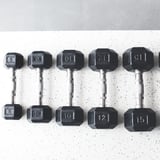dimanche 2 septembre 2018
If You Want to Transform the Shape of Your Body, Read This Now

Does weightlifting feel like a foreign style of training to you? If so, that's completely understandable. Learning a new skill - cooking, a new language, or working out - requires a lot of practice. As a trainer, I've helped many people go from being sedentary to lifting weights multiple times a week. I've laid out a general plan that will help you learn how to move correctly without weights (aka bodyweight exercises), in order to prevent injuries when you do advance to using weights. Get ready to cross off "learn how to lifts weights" from your list of fitness goals with these three simple weightlifting tips.
Start With Bodyweight Exercises
It can be tempting to jump into lifting heavy weights, attempting moves like dumbbell power cleans from the get-go. I don't advise this because you'll be putting yourself at risk for injury. Instead, I suggest learning how to efficiently move your own bodyweight first. Training with just your bodyweight can highlight any muscular imbalances you may have and help you correct them. You'll also learn proper movement patterns and you'll build a foundation of strength. Get started with these exercises:
Once you are comfortable with bodyweight exercises like push-ups, planks, and lunges, advance to learning basic strength training movements with weight.
Learn the Basic Movements
Once you've gotten bodyweight exercises down, it's time to start incorporating using light weights with exercises. If you aren't comfortable going straight to using a barbell and dumbbells, you can utilize various machines in the gym. A progression of this would look like: learning how to do an air squat, then learning how to do smith machine squats, and finally, dumbbell/barbell squats. The basics movements I recommend you learn first are:
Once these moves become second nature, you can continue to progress to more advanced moves like deadlifts and hip thrusts.
Put Your New Skills to Work
Practice makes perfect, especially when it comes to lifting weights. You're going to need to practice these moves often, preferably with the supervision of an experienced trainer. From there you can begin to focus on compound exercises (multiple muscle groups being worked at once) like the squat and press to get the most out of your workout.
If you're new to strength training, I recommend doing three strength training sessions a week. This will give your body ample time to recover and adapt to this new style of training. When it comes to programming, I constantly change the focus and style of each session to create muscle confusion and prevent a plateau. One session may specifically target the lower body, other days may focus on chest and back, and some days will be conditioning (non-stop activity for the entire session). If you aren't sure how to create your own program, this four-week beginner plan is a great resource.










0 comments:
Enregistrer un commentaire